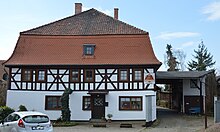Dorfmühle (Bennungen)
The village mill is a listed watermill in Bennungen in the southern Harz municipality in Saxony-Anhalt .
location
It is located in the southern part of the village at the address Mühlgasse 99 at Mühlgraben Bennungen .
Architecture and history
The village mill originally belonged to the Bennungen manor , which had existed since the 10th century. The mill has been documented since 1499. In that year, the mill and the manor were sold by the Stolberg Counts to the brothers Hans and Kurt Barth. There is evidence of a flood in 1546 that led to a five-inch water level in the mill room. In the oldest surviving church book in the village, Martin Kühling is named as master miller for 1682 . In 1699 there was a fatal accident in the area around the mill, when the shepherd's daughter drowned in the mill swamp. 1
In 1729 Friedrich Penoldt acquired the mill from the Heyroth heirs for 1,500 thalers . Penoldt largely rebuilt the mill, and the present house, which was completed at least by 1737, goes back to him. The two-storey half - timbered house is built in the Baroque style and covered with a mansard hipped roof. To build and equip the mill, Penoldt had taken out loans totaling 1,700 thalers from other millers. The mill had two grinding courses as well as a shotgun and an oil mill .
In the period that followed, two further fatal accidents at the mill are documented. In 1755 the student Andreas Eckardt got caught up in the wave. In 1772, on January 16 at 11 p.m., the then miller Heinrich Sanftleben fell under the mill wheel while he was chopping ice and drowned.
For the winter of early 1784 it is said that it was so cold in January and February that the helmets froze too and the mill stood still.
In 1899, the then miller Karl Müller had a plan to generate electricity in the mill for Bennungen, both for private houses and for public street lighting. On July 17, 1899, the Bennungen municipal council voted six to five for the conclusion of a corresponding contract. Corresponding structural changes were probably made in the mill. A power supply for the place through the mill was not implemented.
In 1908 the mill was again hit by a flood and was cut off from the environment for several days.
In 1936 the mill was sold by Ernst Müller to the master miller Alfred Quantity , who came from small bills . Quantity continued to use the mill for grinding, but also operated a threshing machine powered by the mill wheel . However, water power as a regular drive was then replaced by electric motors in 1941, with the water wheel still being used occasionally. In 1942 the shaft was renewed.
Another flood hit the water mill in 1946, several sheep drowned and could not be brought to safety in time. In 1952 the helmet rifle broke . Until the weir was renewed in 1960, the water wheel could not be operated due to the resulting lack of water. In 1960 flour was still ground in the mill. The mill was then taken over by LPG , which only rarely used the facility. After a few years, the shaft made of oak broke, so that the mill wheel was shut down.
In 1972 the mill went to Martin Menge who continued to operate it. Large quantities of meal were ground for livestock farming. In 1993 there was still a grist pit with stones and a hammer mill .
In the local register of monuments , the mill is listed as a monument under registration number 094 83395 .
literature
- Matthias Köhler, Germaid Ruck in Georg Dehio, Handbook of German Art Monuments , Saxony-Anhalt II, Dessau and Halle administrative districts , Deutscher Kunstverlag Munich Berlin 1999, ISBN 3-422-03065-4 , page 54.
Web links
Individual evidence
- ↑ Short question and answer Olaf Meister (Bündnis 90 / Die Grünen), Prof. Dr. Claudia Dalbert (Bündnis 90 / Die Grünen), Ministry of Culture March 19, 2015 Printed matter 6/3905 (KA 6/8670) List of monuments Saxony-Anhalt , page 3092
Coordinates: 51 ° 27 '26.8 " N , 11 ° 7' 1.8" E
